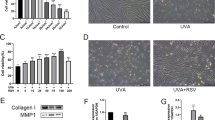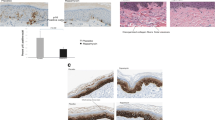Abstract
Purpose
To compare the antifibrotic effect of vitamin E isoforms α-, γ-, and δ-tocotrienol on human Tenon’s fibroblasts (hTf) to the antimetabolite mitomycin C.
Methods
Antifibrotic effects of α- (40, 60, 80, 100, and 120 μM), γ- (10, 20, 30, and 40 μM) and δ-tocotrienol (10, 20, 30, and 40 μM) on hTf cultures were evaluated by performing proliferation, migration and collagen synthesis assays. Whereas for vitamin E the exposure time was set to 7 days to mimic subconjunctival application, cultures were exposed only 5 min to mitomycin C 100 μg/ml to mimic intraoperative administration. Cell morphology (phase contrast microscopy) as an assessment for cytotoxicity and cell density by measuring DNA content in a fluorometric assay to determine proliferation inhibition was performed on day 0, 4, and 7. Migration ability and collagen synthesis of fibroblasts were measured.
Results
All tested tocotrienol isoforms were able to significantly inhibit hTf proliferation in a dose-dependent manner (maximal inhibitory effect without relevant morphological changes at day 4 for α-tocotrienol 80 μM with 36.7% and at day 7 for α-tocotrienol 80 μM with 42.6% compared to control). Degenerative cell changes were observed in cultures with concentrations above 80 μM for α- and above 30 μM for γ- and δ-tocotrienol. The highest collagen synthesis inhibition has been found with 80 µM α-tocotrienol (62.4%) and no significant inhibition for mitomycin C (2.5%). Migration ability was significantly reduced in cultures exposed to 80 µM α- and 30 µM γ-tocotrienol (inhibition of 82.2% and 79.5%, respectively, compared to control) and also after mitomycin C treatment (60.0%). Complete growth inhibition without significant degenerative cell changes could only be achieved with mitomycin C.
Conclusion
In vitro, all tested tocotrienol isoforms were able to inhibit proliferation, migration and collagen synthesis of human Tenon’s fibroblasts and therefore may have the potential as an anti-scarring agent in filtrating glaucoma surgery.




Similar content being viewed by others
References
Addicks EM et al (1983) Histologic characteristics of filtering blebs in glaucomatous eyes. Arch Ophthalmol 101(5):795–798
Jampel HD et al (1988) Cellular proliferation after experimental glaucoma filtration surgery. Arch Ophthalmol 106(1):89–94
Kitazawa Y et al (1991) Trabeculectomy with mitomycin. A comparative study with fluorouracil. Arch Ophthalmol 109(12):1693–1698
Palmer SS (1991) Mitomycin as adjunct chemotherapy with trabeculectomy. Ophthalmology 98(3):317–321
Scott IU et al (1998) Outcomes of primary trabeculectomy with the use of adjunctive mitomycin. Arch Ophthalmol 116(3):286–291
Jampel HD, Pasquale LR, Dibernardo C (1992) Hypotony maculopathy following trabeculectomy with mitomycin C. Arch Ophthalmol 110(8):1049–1050
Lehmann OJ et al (2000) Risk factors for development of post-trabeculectomy endophthalmitis. Br J Ophthalmol 84(12):1349–1353
Membrey WL et al (2000) Glaucoma surgery with or without adjunctive antiproliferatives in normal tension glaucoma: 1 intraocular pressure control and complications. Br J Ophthalmol 84(6):586–590
Mietz H et al (1994) Extraocular application of mitomycin C in a rabbit model: cytotoxic effects on the ciliary body and epithelium. Ophthalmic Surg 25(4):240–244
Smith S, D’Amore PA, Dreyer EB (1994) Comparative toxicity of mitomycin C and 5-fluorouracil in vitro. Am J Ophthalmol 118(3):332–337
Wilkins M, Indar A, Wormald R (2005) Intra-operative mitomycin C for glaucoma surgery. Cochrane Database Syst Rev, 2005(4): p. CD002897
Jiang Q, Ames BN (2003) Gamma-tocopherol, but not alpha-tocopherol, decreases proinflammatory eicosanoids and inflammation damage in rats. Faseb J 17(8):816–822
Mishima K et al (2003) Vitamin E isoforms alpha-tocotrienol and gamma-tocopherol prevent cerebral infarction in mice. Neurosci Lett 337(1):56–60
Tasinato A et al (1995) d-alpha-tocopherol inhibition of vascular smooth muscle cell proliferation occurs at physiological concentrations, correlates with protein kinase C inhibition, and is independent of its antioxidant properties. Proc Natl Acad Sci USA 92(26):12190–12194
Unchern S et al (2003) The effects of vitamin E on platelet activity in beta-thalassaemia patients. Br J Haematol 123(4):738–744
Wu K et al (2001) Inhibitory effects of RRR-alpha-tocopheryl succinate on benzo(a)pyrene (B(a)P)-induced forestomach carcinogenesis in female mice. World J Gastroenterol 7(1):60–65
Haas AL et al (1996) Vitamin E inhibits proliferation of human Tenon’s capsule fibroblasts in vitro. Ophthalmic Res 28(3):171–175
Meyenberg A et al (2005) Tocotrienol inhibits proliferation of human Tenon’s fibroblasts in vitro: a comparative study with vitamin E forms and mitomycin C. Graefes Arch Clin Exp Ophthalmol 243(12):1263–1271
McIntyre BS et al (2000) Antiproliferative and apoptotic effects of tocopherols and tocotrienols on preneoplastic and neoplastic mouse mammary epithelial cells. Proc Soc Exp Biol Med 224(4):292–301
Shun MC et al (2004) Pro-apoptotic mechanisms of action of a novel vitamin E analog (alpha-TEA) and a naturally occurring form of vitamin E (delta-tocotrienol) in MDA-MB-435 human breast cancer cells. Nutr Cancer 48(1):95–105
Tomic-Vatic A et al (2005) Vitamin E amides, a new class of vitamin E analogues with enhanced proapoptotic activity. Int J Cancer 117(2):188–193
Lama PJ, Fechtner RD (2003) Antifibrotics and wound healing in glaucoma surgery. Surv Ophthalmol 48(3):314–346
Nuyts RM, Pels E, Greve EL (1992) The effects of 5-fluorouracil and mitomycin C on the corneal endothelium. Curr Eye Res 11(6):565–570
Crowston JG et al (1998) Antimetabolite-induced apoptosis in Tenon’s capsule fibroblasts. Invest Ophthalmol Vis Sci 39(2):449–454
Beckers HJ, Kinders KC, Webers CA (2003) Five-year results of trabeculectomy with mitomycin C. Graefes Arch Clin Exp Ophthalmol 241(2):106–110
Casson R, Rahman R, Salmon JF (2001) Long-term results and complications of trabeculectomy augmented with low-dose mitomycin C in patients at risk for filtration failure. Br J Ophthalmol 85(6):686–688
Chang PN et al (2009) Evidence of gamma-tocotrienol as an apoptosis-inducing, invasion-suppressing, and chemotherapy drug-sensitizing agent in human melanoma cells. Nutr Cancer 61(3):357–366
Inokuchi H et al (2003) Anti-angiogenic activity of tocotrienol. Biosci Biotechnol Biochem 67(7):1623–1627
Sylvester PW, Shah SJ (2005) Mechanisms mediating the antiproliferative and apoptotic effects of vitamin E in mammary cancer cells. Front Biosci 10:699–709
Weng-Yew W et al (2009) Suppression of tumor growth by palm tocotrienols via the attenuation of angiogenesis. Nutr Cancer 61(3):367–373
Saito Y et al (2004) Characterization of cellular uptake and distribution of vitamin E. Ann N Y Acad Sci 1031:368–375
Fourman S, Wiley L (1991) Tissue plasminogen activator modifies healing of glaucoma filtering surgery in rabbits. Ophthalmic Surg 22(12):718–723
Ophir A (1992) Encapsulated filtering bleb. A selective review: new deductions. Eye 6(Pt 4):348–352
Acknowledgements
The authors thank A. Azzi, Vascular Biology Laboratory at Tufts University, Washington, for his critical review of the manuscript.
Conflicts of interest
Tappeiner C: none; Meyenberg A: none, Goldblum D: none; Mojon D: none; Zingg JM: none; Nesaretnam K: employee of the Malaysian Palm Oil Board, no proprietary interests; Kilchenmann M: none; Frueh BE: none
Author information
Authors and Affiliations
Corresponding author
Additional information
The authors have full control of all primary data and agree to allow the journal to review their data if requested.
Rights and permissions
About this article
Cite this article
Tappeiner, C., Meyenberg, A., Goldblum, D. et al. Antifibrotic effects of tocotrienols on human Tenon’s fibroblasts. Graefes Arch Clin Exp Ophthalmol 248, 65–71 (2010). https://doi.org/10.1007/s00417-009-1168-5
Received:
Revised:
Accepted:
Published:
Issue Date:
DOI: https://doi.org/10.1007/s00417-009-1168-5




